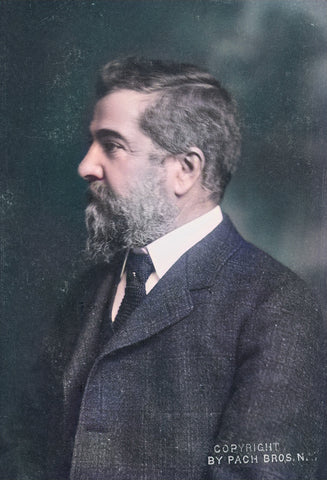The Craftsmanship of Louis Comfort Tiffany: Stained Glass Masterpieces

Louis Comfort Tiffany is a name synonymous with exquisite stained glass artistry. His work, characterized by vibrant colors and intricate designs, has left an indelible mark on the world of decorative arts. Tiffany's stained glass masterpieces are celebrated for their exceptional craftsmanship and artistic innovation, which continue to inspire artists and captivate audiences worldwide.
Born in 1848, Tiffany was the son of Charles Lewis Tiffany, the founder of the renowned jewelry firm Tiffany & Co. While his father's business focused on luxury goods, Louis Comfort Tiffany pursued a different path, one that combined his passion for art with his keen sense of design. He initially trained as a painter but soon found his true calling in the medium of glass. By the late 19th century, Tiffany had established himself as a leading figure in the American Art Nouveau movement.
Tiffany's stained glass creations are not just beautiful objects; they represent a fusion of artistry and technical skill. He pioneered several innovative techniques, including the use of opalescent glass and copper foil, which allowed for greater detail and complexity in his designs. These innovations set Tiffany's work apart from traditional stained glass methods and cemented his reputation as a master craftsman.
The Evolution of Stained Glass Techniques
Stained glass has been used in architecture for centuries, but it was Tiffany's contributions that brought new life to this ancient art form. One of his most significant innovations was the development of opalescent glass. Unlike traditional stained glass, which relied on painting colors onto clear glass, opalescent glass was colored throughout its thickness. This technique gave Tiffany's pieces a luminous quality that changed with varying light conditions.
Another groundbreaking method introduced by Tiffany was the use of copper foil instead of lead came to join pieces of glass. This allowed for more intricate designs and finer details. The copper foil technique became a hallmark of Tiffany's work and enabled him to create stunningly detailed windows, lampshades, and decorative objects.
Tiffany also experimented with layering different types of glass to achieve unique textures and effects. By combining opalescent glass with other materials like textured or iridescent glass, he could create pieces that were rich in color and depth. These techniques not only enhanced the aesthetic appeal of his work but also demonstrated his technical prowess and innovative spirit.
Iconic Works and Their Impact
Tiffany's body of work includes some of the most iconic stained glass creations ever produced. Among these are his famous "Favrile" lamps, which feature intricate floral and geometric patterns rendered in vibrant colors. Each lamp is a testament to Tiffany's ability to blend artistry with functionality, creating objects that are both beautiful and practical.
One of Tiffany's most celebrated works is the "Tree of Life" window at the Arlington Street Church in Boston. This stunning piece features a tree with branches spreading outwards, symbolizing growth and renewal. The use of opalescent glass gives the window a shimmering quality that changes with the light, making it a dynamic piece that continues to captivate viewers.
Another notable creation is the "Magnolia and Irises" window at the Metropolitan Museum of Art in New York City. This masterpiece showcases Tiffany's skill in rendering natural forms with exquisite detail and vibrant colors. The window is a testament to his ability to capture the beauty of nature through the medium of glass.
The Influence on Modern Artists
Tiffany's innovations have had a lasting impact on contemporary stained glass artists. His techniques continue to be studied and emulated by those looking to push the boundaries of this art form. Modern artists like Dale Chihuly have cited Tiffany as an inspiration, incorporating some of his methods into their own work while also exploring new possibilities in glass art.
Chihuly's large-scale installations often feature vibrant colors and organic forms reminiscent of Tiffany's style. By building on Tiffany's legacy, Chihuly has brought stained glass into new contexts, such as public spaces and outdoor environments, further expanding its reach and influence.
Additionally, companies like Judson Studios in Los Angeles have continued to innovate within the field of stained glass by combining traditional techniques with modern technology. Their projects often involve complex designs that require advanced methods similar to those pioneered by Tiffany, demonstrating how his influence persists in contemporary practice.
The Legacy Continues
The legacy of Louis Comfort Tiffany extends beyond his lifetime through institutions dedicated to preserving and promoting his work. The Morse Museum in Winter Park, Florida houses one of the most comprehensive collections of Tiffany's creations. From intricate lamps to elaborate windows, the museum offers visitors an opportunity to experience the full range of Tiffany's artistic achievements.
Tiffany & Co., though primarily known for its jewelry, also pays homage to Louis Comfort Tiffany’s contributions to decorative arts through special collections that celebrate his legacy. These collections often feature designs inspired by his stained-glass masterpieces, blending tradition with contemporary aesthetics.
| Technique | Description | Impact |
|---|---|---|
| Opalescent Glass | Colored throughout its thickness | Luminous quality with changing light conditions |
| Copper Foil | Used instead of lead came for joining pieces | Allowed for more intricate designs |
| Layering Glass | Combining different types for unique effects | Enhanced color richness and texture |
A Call to Appreciate Craftsmanship
The craftsmanship exemplified by Louis Comfort Tiffany is a reminder of the enduring value of artistry and innovation. In a world where mass production often overshadows handmade artistry, Tiffany's work stands as a testament to the beauty that can be achieved through dedication and skill.
For those interested in exploring this rich tradition further, visiting museums that house Tiffany’s works or attending exhibitions dedicated to stained glass art can provide deep insights into this fascinating medium. Whether you're an artist seeking inspiration or simply someone who appreciates fine craftsmanship, Louis Comfort Tiffany’s stained glass masterpieces offer a timeless source of wonder and admiration.